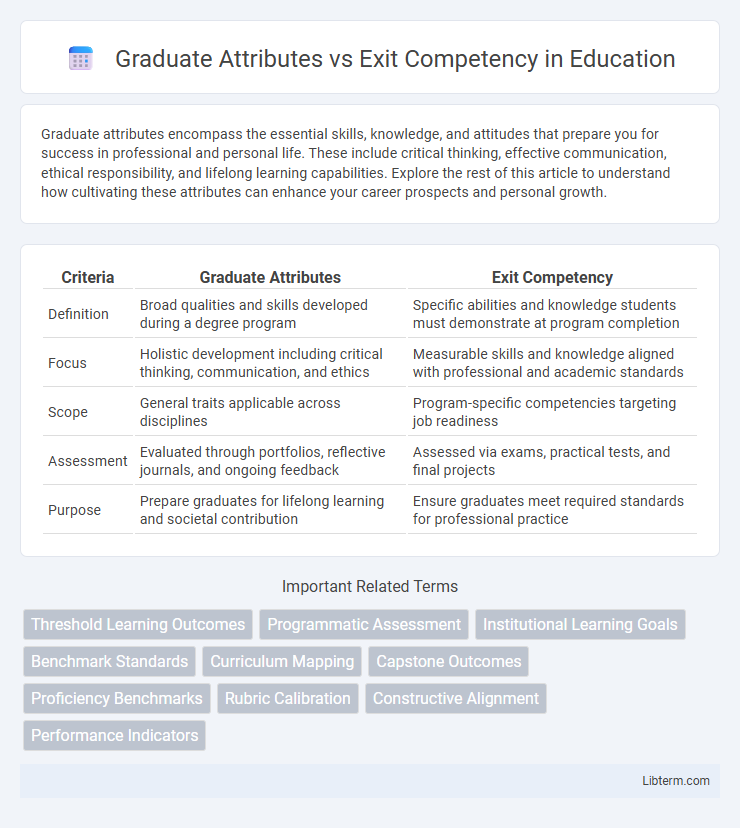Graduate attributes encompass the essential skills, knowledge, and attitudes that prepare you for success in professional and personal life. These include critical thinking, effective communication, ethical responsibility, and lifelong learning capabilities. Explore the rest of this article to understand how cultivating these attributes can enhance your career prospects and personal growth.
Table of Comparison
| Criteria | Graduate Attributes | Exit Competency |
|---|---|---|
| Definition | Broad qualities and skills developed during a degree program | Specific abilities and knowledge students must demonstrate at program completion |
| Focus | Holistic development including critical thinking, communication, and ethics | Measurable skills and knowledge aligned with professional and academic standards |
| Scope | General traits applicable across disciplines | Program-specific competencies targeting job readiness |
| Assessment | Evaluated through portfolios, reflective journals, and ongoing feedback | Assessed via exams, practical tests, and final projects |
| Purpose | Prepare graduates for lifelong learning and societal contribution | Ensure graduates meet required standards for professional practice |
Understanding Graduate Attributes
Graduate Attributes represent the broad qualities, skills, and attitudes expected of students upon completing a program, encompassing critical thinking, communication, and ethical responsibility. These attributes serve as a framework to guide curriculum design, ensuring that graduates meet the holistic demands of their profession and society. Understanding Graduate Attributes helps educators align learning outcomes with industry expectations and lifelong learning goals.
Defining Exit Competency
Exit competency refers to the specific skills, knowledge, and behaviors that students must demonstrate upon completing a program, ensuring they are prepared for professional challenges. It is a measurable outcome that reflects the practical application of learning in real-world contexts, distinct from broader graduate attributes. Defining exit competency involves identifying clear, observable criteria that align with industry standards and academic goals, facilitating effective assessment and targeted skill development.
Key Differences Between Graduate Attributes and Exit Competencies
Graduate attributes represent broad qualities and skills expected of students upon completing a program, such as critical thinking, communication, and ethical reasoning. Exit competencies are specific, measurable abilities aligned with industry standards that graduates must demonstrate before leaving an educational program. While graduate attributes emphasize holistic development, exit competencies focus on practical, job-ready skills tailored to particular professions.
The Role of Graduate Attributes in Higher Education
Graduate attributes serve as essential benchmarks in higher education, defining the knowledge, skills, and attitudes students are expected to develop throughout their academic journey. These attributes guide curriculum design and teaching strategies, ensuring alignment with industry standards and societal needs. Emphasizing graduate attributes helps institutions produce well-rounded graduates equipped for both professional challenges and lifelong learning.
Importance of Exit Competencies in Professional Readiness
Exit competencies define the essential skills, knowledge, and attitudes graduates must demonstrate upon program completion, ensuring alignment with industry standards and job market demands. These competencies directly impact professional readiness by equipping graduates with practical abilities required for successful workplace performance and career progression. Emphasizing exit competencies enables educational institutions to tailor curricula that foster critical thinking, problem-solving, and technical proficiency, leading to higher employability and workforce integration.
Alignment of Graduate Attributes with Industry Needs
Graduate attributes define essential skills and qualities that students must develop throughout their academic journey, ensuring readiness for professional roles. Exit competencies represent specific abilities graduates should demonstrate upon program completion, directly reflecting industry standards and job requirements. Effective alignment between graduate attributes and exit competencies enhances employability by meeting evolving industry needs and facilitating seamless workforce integration.
Assessing Graduate Attributes vs Exit Competencies
Assessing graduate attributes involves measuring broad skills such as critical thinking, communication, and ethical reasoning that students develop throughout their education. Exit competencies focus on evaluating specific, measurable abilities and knowledge that graduates must demonstrate upon program completion, aligned with industry standards and job requirements. Effective assessment strategies integrate both graduate attributes and exit competencies to ensure holistic evaluation of student readiness for professional success.
Curriculum Design: Integrating Attributes and Competencies
Curriculum design strategically integrates graduate attributes and exit competencies to ensure comprehensive skill development aligned with industry standards and academic goals. Graduate attributes encompass broad qualities such as critical thinking, communication, and ethical reasoning, while exit competencies specify measurable skills students must demonstrate upon program completion. Effective curriculum frameworks map these attributes to specific competencies, facilitating targeted learning outcomes and assessment methods that enhance graduate readiness.
Challenges in Measuring Attributes and Competencies
Measuring graduate attributes often presents challenges due to their abstract and holistic nature, encompassing traits like critical thinking and ethical reasoning that lack standardized assessment metrics. Exit competencies, typically defined as specific skills and knowledge acquired by the end of a program, can be more directly evaluated through tests or practical demonstrations but still face difficulties in ensuring consistency across diverse educational contexts. Both require robust, multifaceted assessment strategies integrating qualitative and quantitative data to accurately capture student capabilities and inform curriculum development.
Future Trends in Graduate Outcomes Evaluation
Graduate attributes emphasize broad skills such as critical thinking, communication, and ethical reasoning, while exit competencies focus on specific abilities required for job readiness and professional tasks. Emerging future trends in graduate outcomes evaluation prioritize integrating real-time data analytics, employer feedback, and adaptive learning technologies to measure both attributes and competencies more dynamically. This shift enables higher education institutions to tailor curricula to evolving industry demands and enhance alignment with workforce needs.
Graduate Attributes Infographic

 libterm.com
libterm.com